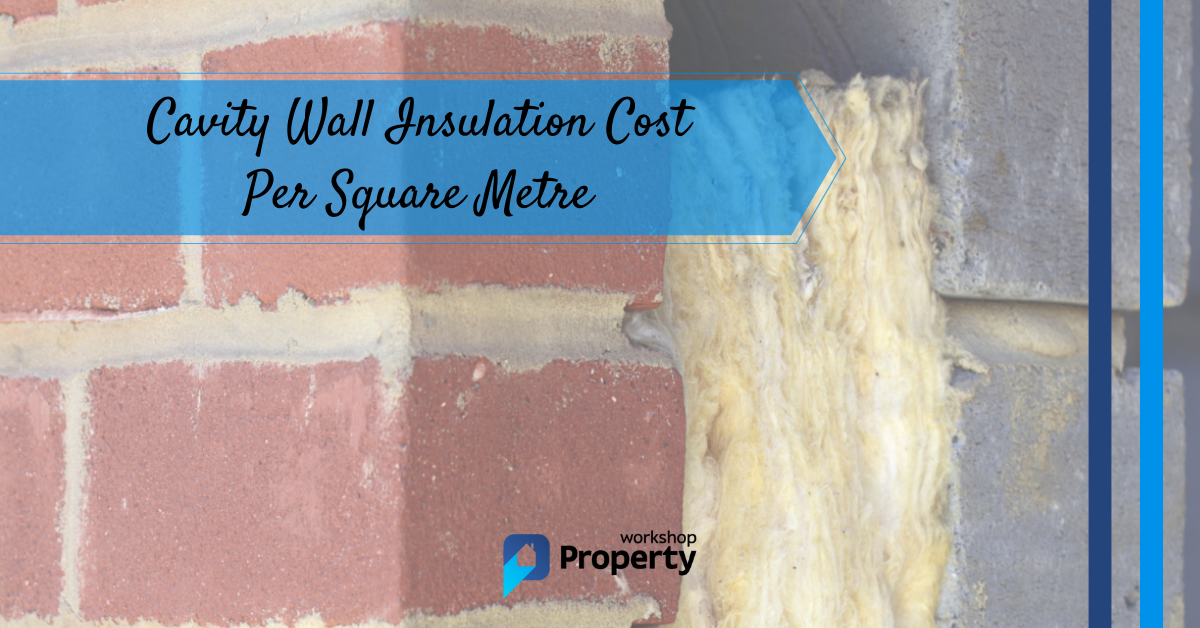There is nothing new about insulating cavity walls. We’ve been doing it since the oil crisis in the 1970s. Still, people only started taking it seriously in the mid-80s when changes to the Building Regulations forced housebuilders and designers to re-think construction methods. I know because I was one of them.
I’ve based this cost guide on my experience and research into available methods & materials in the UK. So after reading this comprehensive guide, you’ll have a solid understanding of the latest cavity wall insulation cost per m².
In a Hurry? Find top-rated builders in your area by clicking the button below:
Why Insulate a Cavity Wall?
According to The Green Age blog, heat loss through an uninsulated cavity wall accounts for around 35% of your energy bill! And then there’s the environmental issue — the amount of carbon used in creating this excess energy all adds to our nation’s carbon footprint.
After introducing the Building Regulations 1985, I seemed to spend most of my time calculating U-values for all elements of a house structure. U-value measures thermal transmittance — the lower the value, the greater the resistance to heat loss.
Although they’ve been around since the 1960s, the required U-value for walls dropped from 1.7 in 1965 to 1.0 in 1976 and 0.6 in 1985. It was a massive drop requiring a significant re-think of how we insulated our homes. We now had to consider the whole structure rather than the individual elements.
A new industry was born as the need to reduce heat loss through walls spread into the residential housing market.
Hire a Professional or DIY?
Going back to the early days of post-construction cavity wall insulation, we saw the problems caused by inferior installation methods and incorrect use of materials. Most of these issues were down to contractors taking shortcuts or botched DIY attempts.
Pro Tip: Read our guide to cavity wall insulation removal if you first need to fix poorly fitted insulation.
I recommend hiring a professional to avoid repeating the mistakes of the 1980s. However, you first need to consider the following factors:
- The type of insulation material
- The expertise of the contractor
- The cost of materials and labour
- Do you even have a cavity?
For contractors in your area, check out Rated People.
I’ll take that last point first. It may sound obvious, but just because your house was built in the 1930s or later doesn’t mean it has a cavity between the inner and outer leaf of brickwork.
My previous home hails from the mid-30s, and although the front elevation is solid engineering brick, the sides and rear were of lesser quality. Also, along the side and rear walls, you could see a row of headers every 4 or 5 courses, indicating that it was a solid wall.
Another way to check is to measure the thickness of the wall — best measured at door openings. If the thickness is around 270mm to 300mm (including the plaster), it’s most likely a cavity wall. If the thickness is less than 250mm, it’s either solid or has a very narrow cavity.
Types of Insulation Material
Specialists offer many different options, but they generally boil down to the following:
- Polystyrene beads
- Blown mineral fibre
- Polyurethane foam
Let’s take a look at each one of these options.
Polystyrene (EPS) Beads
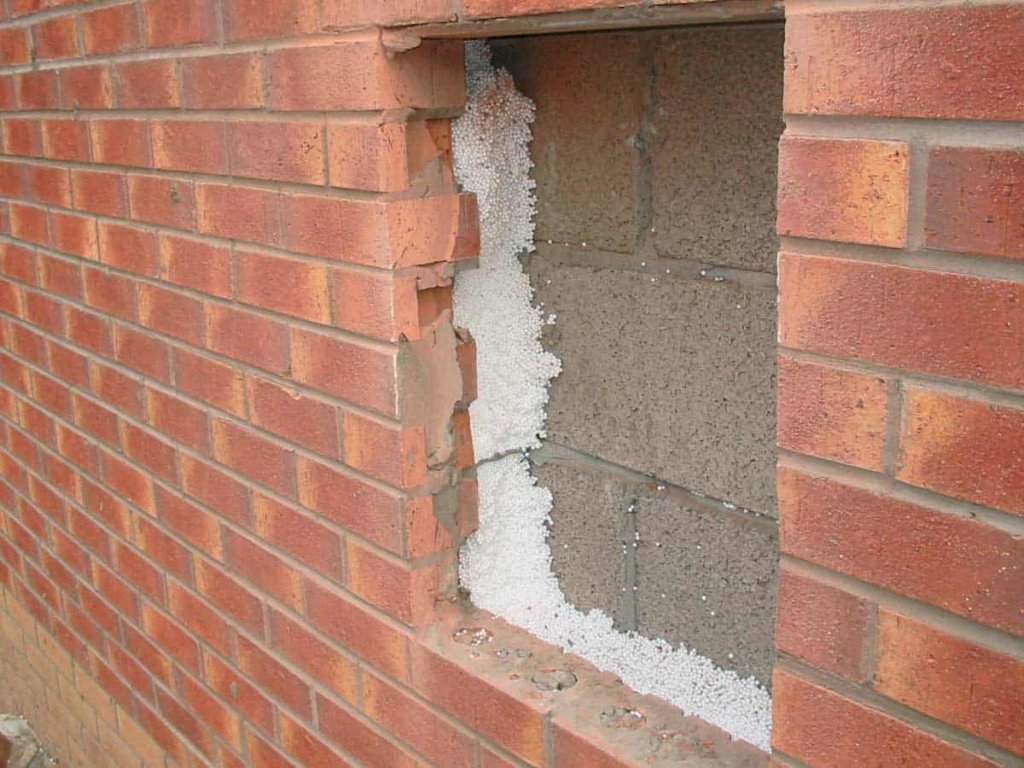
Polystyrene beads are blown into the cavity using compressed air and mixed with an adhesive. This adhesive cures inside the cavity, providing a solid layer of insulation that repels moisture.
Although the beads bond together as they move into the cavity, this isn’t always effective, and if you cut a hole in the wall, you may find beads falling out of the cavity. Be prepared to seal this right away.
Blown Mineral Fibre
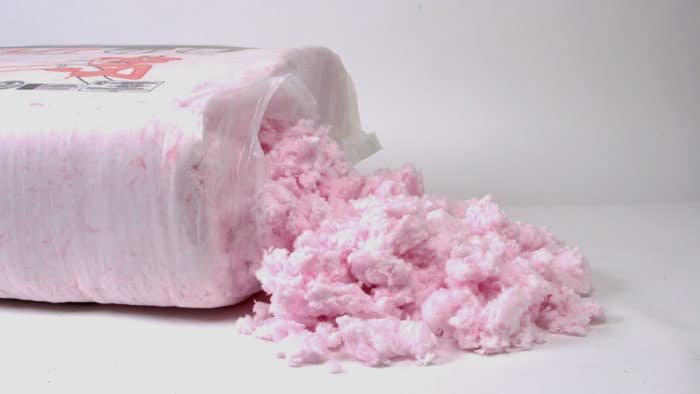
Blown mineral fibre consists of glass fibre strands or mineral (rock) wool, similar to loft insulation but in smaller clumps.
The fibre is blown into the cavity using compressed air, and because the nozzle is larger than the one used for polyurethane foam, it results in a slightly larger hole in your brickwork.
Blown mineral fibre is not suitable for cavities smaller than 50mm. So you can’t use it to fill a cavity containing insulation boarding, as was common practice in the late 70s and 80s.
Polyurethane (PU) Foam
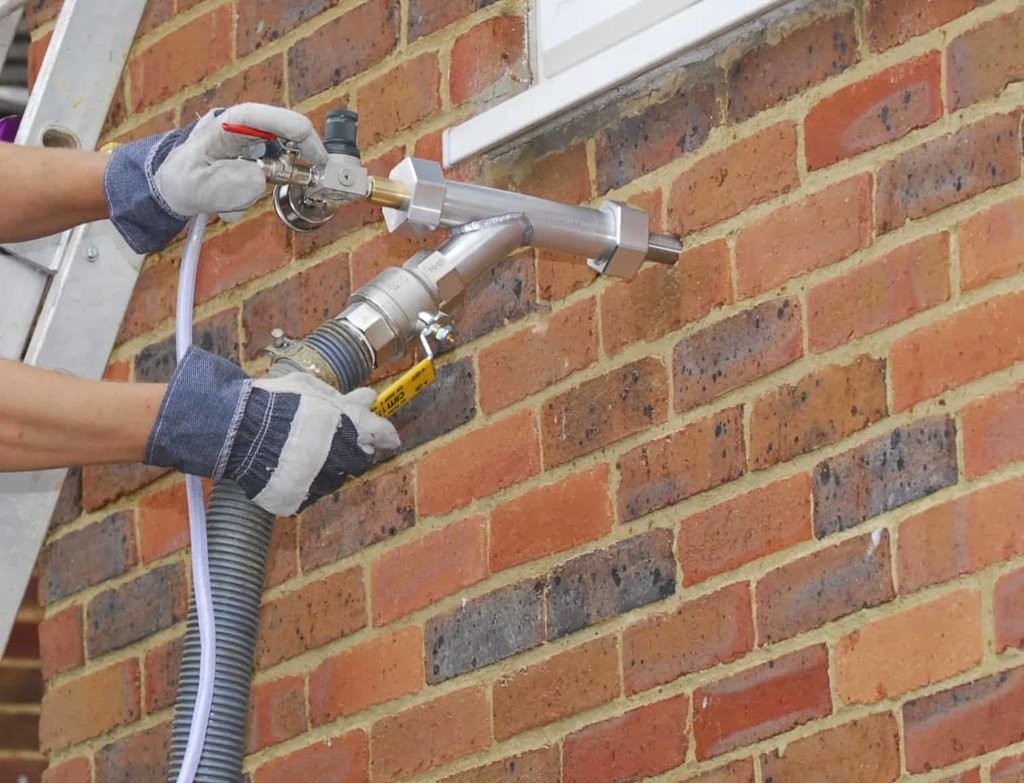
Polyurethane foam develops inside the cavity when two chemical components travel through a small hole. The chemicals combine and create a foam, which expands to fill the cavity and every crack it can find.
This foam expansion means that greater expertise is required to prevent it from expanding into areas you don’t want it. These unwanted areas include the eaves, where foam blocks roof space ventilation.
PU foam bonds the two leaves of brickwork together to create a much more robust wall construction, which is helpful if the wall ties fail (see below). To see how this works, check out this video by Fusion Insulation.
What To Consider When Insulating A Cavity Wall
Before you hire a cavity wall insulation professional, consider the following points:
Air Bricks
Air bricks can present a problem whichever method you choose. Air bricks are there for a purpose, either to ventilate the cavity or to ventilate a space inside.
If the air brick ventilates a cavity, only worry about the material pouring through the holes because there isn’t a cavity to ventilate once the work’s complete.
However, if the air brick ventilates a room for a specific reason (e.g. a flueless gas fire requires ventilation to prevent the build-up of carbon monoxide), you must maintain the air brick. The installers should know how to do this. If they don’t, you’ve picked the wrong one!
BBA Certification
Installers should only use materials with a British Board of Agrément (BBA) certificate. Be very cautious if they promote their own “unique” product and don’t have a BBA certificate.
Check out previous installations and the guarantee they offer — is it a third-party guarantee that covers you if the company goes bust? If not, walk away! Most reputable companies offer a 25-year warranty from the Cavity Wall Insulation Guarantee Agency (CIGA).
Wall Condition
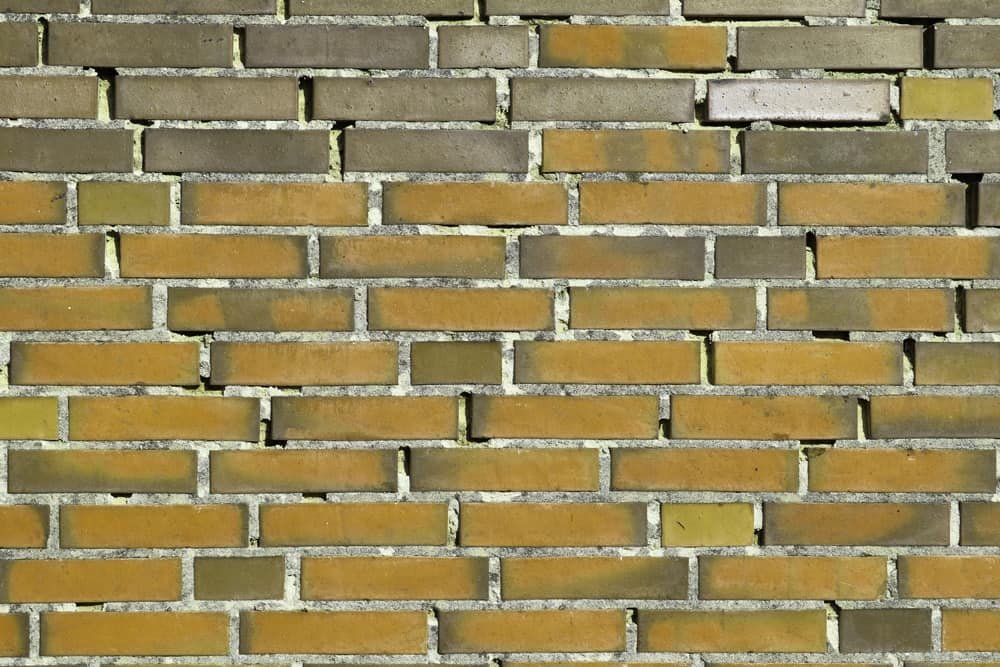
Check the condition of the wall. If necessary, bring in a surveyor to take a look.
The main things to look for are cracks and bulges. Cracks can be due to settlement, so you should monitor this over time. If it’s an ongoing problem, you should deal with it before proceeding with the cavity insulation.
Many pre-war houses in industrialised cities suffered damage from bombing, even if they weren’t involved in a direct hit. The pressure from a nearby explosion often sucked the outer leaf away from the inner leaf. If the wall’s condition hasn’t changed over the years, don’t worry about it.
However, if the bulge, or bulges, have occurred more recently and cracks are evident, the wall ties have most likely failed. Wall ties are metal ties that bond the inner and outer leaves together, and in older houses, iron or untreated steel is standard. Over the years, these ties rust and expand, pushing the brickwork out. Eventually, they snap as the rust eats through the metal, leaving nothing to hold the two leaves together.
If this issue happens, you must replace the wall ties before installing insulation. It’s not a tremendous job but can cost anything from £1,000 to £2,000 depending on the number of ties. This cost may be a factor that swings you towards PU foam.
Cavity Wall Insulation Costs in 2024
Below is a breakdown of the average costs you can expect to pay when insulating your cavity wall in the UK:
Material Cost
| Material | Cost/m2 |
|---|---|
| Polystyrene beads | £18–£22 |
| Blown mineral fibre | £13–£18 |
| Polyurethane foam | £22–£26 |
Whole Property Cost
| Type of Property | Average Cost |
|---|---|
| Detached property | £725 |
| Semi-detached property | £475 |
| Mid-terrace | £370 |
| Bungalow | £430 |
I know some people quote prices for flats, but this is impossible because you can’t insulate the cavity of an individual flat. Instead, you must insulate the whole block in one go. That said, if you own a block of flats, you should allow roughly £300–£400 per unit.
When obtaining quotes, ensure you get a fixed price for the complete job, not cost-per-hour. Cost/m² is fine for comparing quotes, but let the contractor estimate and give you a fixed price. This way, any mistake is at their cost, not yours.
Don’t fancy doing this job yourself? Find top-rated builders in your area by clicking the button below:
Final Thoughts
Installing cavity wall insulation is probably the most cost-effective way to reduce energy bills, especially if your energy supplier pays for some of it.
But, as you can see from past mistakes, you must know how to insulate your home properly. Poorly installed insulation is costly to rectify, so if you’re unsure, get quotes from competent contractors in your local area using Rated People.
FAQ
Below are the answers to frequently asked questions about cavity wall insulation:
What is the payback period?
Depending on your heating method, you can expect to have saved in energy costs what you paid for insulation in around five years. According to ‘Which?‘, you can save between £85 and £280 a year by insulating your cavity walls.
How long does it take to install?
An average property should take half a day to complete. However, it’s usually the next day before you fill in the holes because an inspector has to sign it off. When it’s finished, the filled holes should be barely noticeable.
Are there any “green” alternatives?
None of these products is “environmentally friendly” in production or during their after-life. However, there is a product you can look at — sheep’s wool fibre. Sheep’s wool has similar properties as mineral fibre and fills the cavity similarly. However, at £25–£30/m2, it’s more expensive than other materials on the market.
I don’t have a wall cavity. Is there anything else I can do?
Yes, you can add external insulation and render over it. Alternatively, you can board out the inner face of the external walls. Most people choose the first option because it’s less disruptive to everyday living.
Are there any grants available for cavity wall insulation?
Grants are down to your energy supplier. According to ‘Which?‘, some energy companies offer free insulation or grants to help you make your home more energy-efficient through the government’s Energy Company Obligation (ECO) Scheme.
Which material has the best insulation value?
Materials are measured using the R-value, the resistance to heat flow through a given thickness. The higher the R-value, the better it insulates.
Going back to the earlier comments about calculating U-values, the U-value of a particular element is the inverse of the sum of all the R-values that make up the element, such as brick, insulation, block, plaster, etc. I.e. U = 1/(R1+R2+R3…).
These are approximate values for comparison only:
| Insulation Type | R-Value/25mm |
|---|---|
| EPS beads | 5 |
| Glass fibre | 3.4 |
| Mineral wool | 3.8 |
| Polyurethane | 6.8 |
Checking back on the costs, the cheapest (blown mineral fibre) is the least efficient, and the most expensive (PU) is the best insulator — it makes sense.

